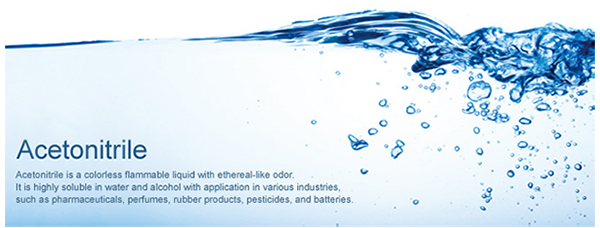Blog - Aure Chemical
Choose Acetonitrile for Analytical Chemistry and Volatile Solvent Needs
Acetonitrile (MeCN), with its simple linear structure CH₃CN, is a polar aprotic solvent characterized by low viscosity, high volatility, and excellent solvating power for polar and ionic compounds. It has gained prominence in analytical chemistry, particularly in high-performance liquid chromatography (HPLC), where its properties enable precise separations and detections. This article aims to elucidate why acetonitrile is frequently the optimal choice for analytical applications requiring volatility, such as chromatography and mass spectrometry, as well as for synthesis and purification processes where easy solvent removal is essential, providing guidance for chemists and researchers in selecting it over alternatives.
solvent characterized by low viscosity, high volatility, and excellent solvating power for polar and ionic compounds. It has gained prominence in analytical chemistry, particularly in high-performance liquid chromatography (HPLC), where its properties enable precise separations and detections. This article aims to elucidate why acetonitrile is frequently the optimal choice for analytical applications requiring volatility, such as chromatography and mass spectrometry, as well as for synthesis and purification processes where easy solvent removal is essential, providing guidance for chemists and researchers in selecting it over alternatives.
Key Properties of Acetonitrile
Acetonitrile's polarity is evidenced by its dielectric constant of approximately 37.5 at 20°C, making it effective for dissolving polar and ionic solutes without proton donation. Its volatility stems from a low boiling point of 81.6–82°C, facilitating quick evaporation post-use. With a viscosity of 0.369 cP at 25°C, it supports efficient flow in chromatographic systems and electrochemical setups, reducing backpressure and enhancing mass transfer.
In terms of miscibility, acetonitrile blends seamlessly with water, alcohols, ethers, and many organic solvents like acetone, enabling versatile mixtures for gradient elutions or extractions. These attributes collectively position it as a solvent that balances polarity with practical handling advantages.
Acetonitrile in Analytical Chemistry
Acetonitrile is indispensable in HPLC as a mobile phase solvent, owing to its UV transparency (low absorbance below 210 nm), low background noise, and ability to form stable gradients with water for reversed-phase separations. In liquid chromatography–mass spectrometry (LC–MS), its high volatility promotes efficient desolvation in the ion source, minimizing adduct formation and enhancing sensitivity for trace analysis.
For electrochemical studies, acetonitrile offers a wide electrochemical window (typically -2.5 to +2.5 V vs. Ag/AgCl), supporting investigations of redox processes without solvent breakdown. Case examples include pharmaceutical analysis, where it enables quantification of drugs like antibiotics in complex matrices, and environmental monitoring for pollutants such as pesticides in water samples, ensuring high resolution and reproducibility.
Acetonitrile as a Volatile Solvent in Synthesis & Purification
Acetonitrile's low boiling point allows for easy removal by rotary evaporation or distillation, making it ideal for reactions necessitating rapid solvent exchange or product isolation without thermal degradation. It excels in sample preparation, such as solid-phase extraction, and in crystallization processes where controlled evaporation yields pure crystals.
Compared to other volatile solvents like acetone (boiling point 56°C, protic) or dichloromethane (40°C, halogenated), acetonitrile's aprotic polarity provides unique strengths: it dissolves salts better than acetone and is less environmentally harmful than DCM, which is restricted due to ozone depletion potential. This makes it preferable for organometallic syntheses or purifications requiring inert, polar conditions.
Comparison with Other Polar Aprotic Solvents
While acetonitrile is specialized for volatility and analytics, it contrasts with broader solvents like DMSO, DMF, and NMP. The table below compares key attributes:
| Property | Acetonitrile | DMF | DMSO | NMP |
| Dielectric constant | 37 | 37 | 47 | 32 |
| Dipole moment (D) | 3.9 | 3.8 | 4 | 4.1 |
| Boiling point (°C) | 82 | 153 | 189 | 202 |
| Toxicity | Flammable, moderate | Moderate (liver risk) | Low (skin penetration risk) | High (reprotoxic) |
| Applications | HPLC, synthesis | Polymers, synthesis | Pharma, electrochemistry | Polymers, coatings |
Acetonitrile is less versatile as a universal solvent due to its narrower solvency range but stands out for applications prioritizing speed, low residue, and analytical clarity.
Safety and Handling Considerations
Acetonitrile has a relatively low acute toxicity profile, with potential for irritation to eyes, skin, and respiratory tract, and metabolism to cyanide in high exposures. It is flammable (flash point 5.5°C), requiring storage away from ignition sources and strong oxidizers. OSHA sets a PEL of 40 ppm TWA with skin notation, while NIOSH recommends 20 ppm TWA.
Handling involves using nitrile gloves, goggles, and fume hoods; spills should be absorbed with inert materials and ventilated. In analytical labs with high volumes, waste management is critical—incineration or recycling to prevent release, as it is not readily biodegradable.
Market and Supply Considerations
Acetonitrile is widely available from major chemical suppliers, with production tied to acrylonitrile manufacturing, leading to supply fluctuations from feedstock availability or demand in textiles. As of 2025, prices hover around 2301 USD/MT in the USA, with global market size at approximately 325.2 million USD, projected to grow at 5.5% CAGR to 567.5 million by 2035.
Sustainability concerns include its non-biodegradable nature and potential for pollution, though high efficiency in low volumes offsets impacts; recovery techniques like distillation promote greener use.
Acetonitrile emerges as the premier choice for analytical chemistry, thanks to its UV transparency, volatility, and seamless compatibility with LC–MS, ensuring accurate and efficient analyses. Its secondary benefits as a volatile solvent enhance synthesis and purification workflows by simplifying removal and minimizing residues. A practical tip: Opt for acetonitrile when priorities include speed, low viscosity for flow systems, and analytical precision, while adhering to safety protocols for optimal results.
Looking for a reliable bulk supplier of Acetonitrile (CAS 75-05-8)?
Aure Chemical provides Premium Acetonitrile (CAS 75-05-8) raw materials.
View our Acetonitrile (CAS 75-05-8) product page
